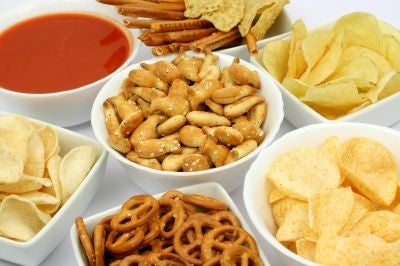Your support helps us to tell the story
From reproductive rights to climate change to Big Tech, The Independent is on the ground when the story is developing. Whether it's investigating the financials of Elon Musk's pro-Trump PAC or producing our latest documentary, 'The A Word', which shines a light on the American women fighting for reproductive rights, we know how important it is to parse out the facts from the messaging.
At such a critical moment in US history, we need reporters on the ground. Your donation allows us to keep sending journalists to speak to both sides of the story.
The Independent is trusted by Americans across the entire political spectrum. And unlike many other quality news outlets, we choose not to lock Americans out of our reporting and analysis with paywalls. We believe quality journalism should be available to everyone, paid for by those who can afford it.
Your support makes all the difference.More low sodium, high fiber snack foods are expected to line grocery store shelves in the coming months, according to industry observers.
With governments and public health bodies increasingly sounding the alarm on high sodium diets, the snack food industry - often singled out for producing salty, guilty pleasures - will be responding with healthier and heart-friendly alternatives.
That's the assessment of James McCarthy, president and CEO of the Snack Food Association, who will be presiding over the 74th annual Snaxpo exposition in Orlando, Florida from March 20 to March 23.
"There is a trend being led by the major snack companies to reduce sodium in their products," wrote McCarthy in an email response. "Also, the trend toward whole grains continues in snacks. The number of snacks that are high in fiber are also becoming more prevalent."
In January, a new set of US guidelines called for Americans to reduce their sodium intake to less than 2,300 mg a day. Those at increased risk - people aged 51 and older, African Americans, those who suffer from hypertension, diabetes, or chronic kidney disease - were advised to further reduce their salt intake to 1,500 mg. That amounts to half the US population, including children and the majority of adults.
The market for whole grain and high fiber snacks is also growing, he said, as are gluten-free products - the byproduct of the trendy gluten-free diet popularized by American celebrities like Gwyneth Paltrow and The View host Elisabeth Hasselbeck.
Gluten is a protein found in many foods like breads, pasta, wheat, barley, and rye.
Nuts and legumes are also becoming increasingly popular snack options for their health benefits, McCarthy pointed.
Interest in low-fat snacks also continues to dominate the industry.
According to a recent report from ShopSmart magazine, a sister publication of Consumer Reports, some snack foods just masquerade as health foods.
"Don't let seemingly healthful foods derail your diet," said Lisa Lee Freeman, editor-in-chief of ShopSmart. "If you think you're making a good choice by having a bran muffin or trail mix for breakfast instead of a bowl of cereal, you could be undermining your health - with lots of fat - and sabotaging your waistline with excess calories."
Freeman identifies products like vegetable chips, (which are high in fat and calories,) granola cereal (high in sugar, fat and calories) and turkey hot dogs (high in fat, sodium and nitrates) as diet saboteurs.

Join our commenting forum
Join thought-provoking conversations, follow other Independent readers and see their replies
Comments